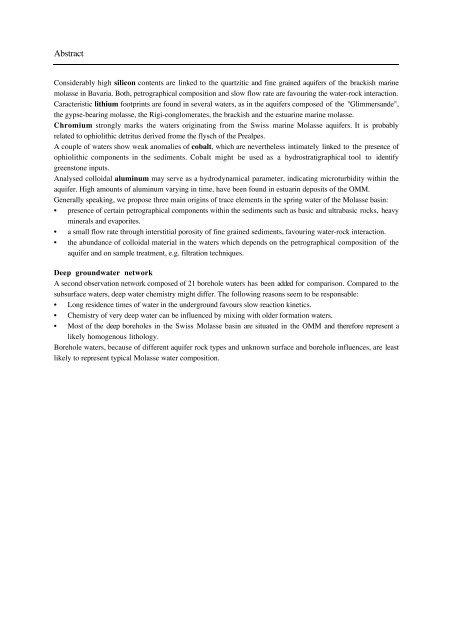typologie des eaux souterraines de la molasse entre chambéry et linz
typologie des eaux souterraines de la molasse entre chambéry et linz
typologie des eaux souterraines de la molasse entre chambéry et linz
You also want an ePaper? Increase the reach of your titles
YUMPU automatically turns print PDFs into web optimized ePapers that Google loves.
Abstract<br />
Consi<strong>de</strong>rably high silicon contents are linked to the quartzitic and fine grained aquifers of the brackish marine<br />
mo<strong>la</strong>sse in Bavaria. Both, p<strong>et</strong>rographical composition and slow flow rate are favouring the water-rock interaction.<br />
Caracteristic lithium footprints are found in several waters, as in the aquifers composed of the "Glimmersan<strong>de</strong>",<br />
the gypse-bearing mo<strong>la</strong>sse, the Rigi-conglomerates, the brackish and the estuarine marine mo<strong>la</strong>sse.<br />
Chromium strongly marks the waters originating from the Swiss marine Mo<strong>la</strong>sse aquifers. It is probably<br />
re<strong>la</strong>ted to ophiolithic <strong>de</strong>tritus <strong>de</strong>rived frome the flysch of the Prealpes.<br />
A couple of waters show weak anomalies of cobalt, which are nevertheless intimately linked to the presence of<br />
ophiolithic components in the sediments. Cobalt might be used as a hydrostratigraphical tool to i<strong>de</strong>ntify<br />
greenstone inputs.<br />
Analysed colloidal aluminum may serve as a hydrodynamical param<strong>et</strong>er, indicating microturbidity within the<br />
aquifer. High amounts of aluminum varying in time, have been found in estuarin <strong>de</strong>posits of the OMM.<br />
Generally speaking, we propose three main origins of trace elements in the spring water of the Mo<strong>la</strong>sse basin:<br />
• presence of certain p<strong>et</strong>rographical components within the sediments such as basic and ultrabasic rocks, heavy<br />
minerals and evaporites.<br />
• a small flow rate through interstitial porosity of fine grained sediments, favouring water-rock interaction.<br />
• the abundance of colloidal material in the waters which <strong>de</strong>pends on the p<strong>et</strong>rographical composition of the<br />
aquifer and on sample treatment, e.g. filtration techniques.<br />
Deep groundwater n<strong>et</strong>work<br />
A second observation n<strong>et</strong>work composed of 21 borehole waters has been ad<strong>de</strong>d for comparison. Compared to the<br />
subsurface waters, <strong>de</strong>ep water chemistry might differ. The following reasons seem to be responsable:<br />
• Long resi<strong>de</strong>nce times of water in the un<strong>de</strong>rground favours slow reaction kin<strong>et</strong>ics.<br />
• Chemistry of very <strong>de</strong>ep water can be influenced by mixing with ol<strong>de</strong>r formation waters.<br />
• Most of the <strong>de</strong>ep boreholes in the Swiss Mo<strong>la</strong>sse basin are situated in the OMM and therefore represent a<br />
likely homogenous lithology.<br />
Borehole waters, because of different aquifer rock types and unknown surface and borehole influences, are least<br />
likely to represent typical Mo<strong>la</strong>sse water composition.

















